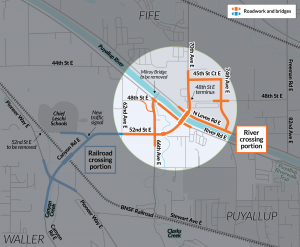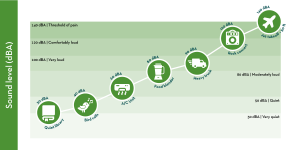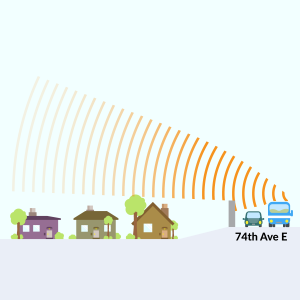A section of the Canyon Road Regional Connection Project is getting a noise wall. Here’s what you need to know.
When the Canyon Road Regional Connection Project is complete, 70th Avenue East will continue across the Puyallup River to join Canyon Road East. Pierce County is also building a new road, 74th Avenue East, to connect North Levee Road East to 45th Street Court East, just to the east of 70th Avenue East.

As part of our planning for the future 74th Avenue East, we completed an environmental study of a variety of factors including expected noise levels. We found the new road will add enough noise near several homes within the Ardena Gale Mobile Home Park community to require that we consider adding a noise wall.
So, how did we get to that point?
When Pierce County is considering whether to include a noise wall or barrier in a project, we follow the steps in the Washington State Department of Transportation (WSDOT) noise walls and barriers guidelines, summarized here:
- Step 1, Noise analysis: We engage acoustical specialists, or sound scientists, to measure and analyze the sources, levels, and patterns of existing noise at properties like parks, homes and neighborhoods near the project. This usually includes installing special microphones, called receivers, throughout the project area to measure noise, then developing a computerized noise model to predict how those existing noise levels could change with the new road.
- Step 2, Determination of impact: According to the Washington State Department of Transportation, a project should consider a noise wall for properties where the expected noise from the new road is predicted to be 66 decibels (dBA) or more. At 66 dBA, two people standing three feet apart are likely to find they need to raise their voices to hear each other. The guidelines also ask us to consider a noise wall when the expected increase in noise level is 10 dBA or more. 10 dBA could be the difference between hearing a food blender while you are standing next to it or standing by the side of the road when a heavy truck goes by.

- Step 3, Evaluate “feasibility” and “reasonableness”: Proposed noise walls must be both feasible and reasonable for construction. To be feasible, we must be able to build the noise wall using standard construction materials and techniques, while providing noise reduction of at least 5 dBA. To be reasonable, the noise wall must be cost effective to build. For example, if it would take a wall that is 30 feet high to reduce noise by 5 dBA for one house, it would be feasible (because it is possible to build a 30-foot wall) but not reasonable, because the cost of building a 30-foot wall to reduce the expected noise for one house is much more than the benefit it would provide.
- Step 4, Property owner and resident input: Once we determine that a noise wall is feasible and reasonable, we leave the final decision to build a noise wall up to the community members who would be most impacted by the additional noise. This means asking those who live in and own the houses closest to where the wall would be built to vote on whether or not to build the wall.

In the case of the new 74th Avenue East, we met with the residents and property owners of the homes in Ardena Gale that would be most impacted by noise from the new road and gave them as much information as possible so they could make a decision about a noise wall. This included details about the new road, expected changes in traffic noise, what we think the wall would look like, how tall it would be, and how far it would be from their houses. In December, we polled them about their preference for a noise wall. In the end, the property owner and a majority of the affected residents said they would prefer to include the noise wall in the project.
If you have questions about this noise wall process, please email us at canyonroadconnection@piercecountywa.gov.
